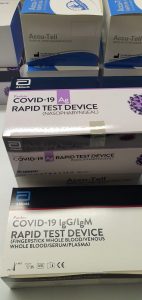Mechanisms of impaired fatty acid metabolism will not be the similar in nondialysis and hemodialysis patients. Correlations between the serum free carnitine concentration (FC), acylcarnitine concentration (AC), acyl to free carnitine ratio (AC/FC) and estimated glomerular filtration charge (eGFR) in the nondialysis inhabitants and the length of hemodialysis in hemodialysis patients have been investigated. As the eGFR decreased, the FC and AC elevated, and as the length of hemodialysis turned longer, the FC and AC decreased.
The AC/FC elevated constantly as the eGFR decreased and the length of hemodialysis elevated. As an exception, the AC/FC decreased in the patients with a hemodialysis length lower than 90 days, which was not defined by carnitine elimination by hemodialysis. In nondialysis patients, a useful, somewhat than an absolute, carnitine deficiency is a primary reason behind impaired fatty acid metabolism. Long-term hemodialysis exacerbates absolute carnitine deficiency, whereas hemodialysis therapy might enhance impaired fatty acid metabolism.
Effects of Dietary Indole-3-Acetate Sodium on Laying Performance, Egg Quality, Serum Hormone Levels and Biochemical Parameters of Danzhou Chickens
This examine was carried out to examine the results of indole-3-acetate sodium (IAA-Na) inclusion in diets on the egg manufacturing efficiency, egg high quality, intestinal tissue morphology, serum hormone ranges and biochemical parameters of Danzhou chickens to preliminarily discover the efficacy of IAA-Na as a feed additive. A complete of 192 Danzhou chickens (50 weeks previous) have been randomly assigned to 2 teams of 96. The diets for the therapy group consisted of the basal diets, supplemented with IAA-Na (200 mg/kg).
The formal feeding trial lasted for 4 weeks. The outcomes confirmed that the feed supplemented with IAA-Na not solely elevated the laying charge (p < 0.05) and egg yolk ratio (0.05 < p < 0.1), but additionally considerably lowered the feed:egg ratio (p < 0.05). In addition, the dietary supplementation of IAA-Na considerably elevated the serum estradiol ranges (p < 0.05) and decreased serum alkaline phosphatase exercise (p < 0.05).
Compared with the management group, the addition of IAA-Na to the weight-reduction plan had no important impact on the intestinal tissue morphology or serum antioxidant capability of Danzhou chickens. This examine preliminarily gives proof that dietary IAA-Na can enhance laying efficiency, indicating that IAA-Na is a doubtlessly efficient feed additive for laying hens, however additional research are required earlier than arriving at particular conclusions.
The Effects of Zinc Sulfate Supplementation on Serum Copeptin, C-Reactive Protein and Metabolic Markers in Zinc-Deficient Diabetic Patients on Hemodialysis: A Randomized, Double-Blind, Placebo-Controlled Trial
We aimed to examine the affiliation between zinc (Zn) supplementation and serum ranges of copeptin, high-sensitive C-reactive protein (hs-CRP), glycemic management, anthropometric parameters and renal operate in Zn -deficient diabetic hemodialysis patients (DHPs). This randomized, double-blind, placebo-controlled trial (RCT) was carried out on 46 DHPs with Zn-deficiency.
The Zn complement group (n = 21) acquired a 220-mg/day Zn sulfate capsule (containing 50 mg Zn), and the management group (n = 25) acquired a placebo capsule (220 mg corn starch), for eight weeks. Fasting, predialysis blood samples have been taken at baseline and after eight weeks to assess fasting blood glucose (FBG), serum insulin, copeptin, high-sensitive C-reactive protein (hs-CRP), blood urea nitrogen (BUN), creatinine (Cr) concentrations, and homoeostatic mannequin evaluation (HOMA-IR) and quantitative insulin-sensitivity verify index (QUICKI).
Compared to controls, serum copeptin (P < 0.001), hs-CRP (P < 0.001), BUN (P < 0.001), Cr (P < 0.001), Zn (P < 0.001), FBG (P < 0.001) ranges, BMI (P < 0.001), and physique weight (P < 0.001) have been considerably affected following ZnSO4 supplementation for eight weeks. In distinction, QUICKI (P = 0.57), HOMA-IR (P = 0.60), and serum insulin (P = 0.55) weren’t affected following Zn supplementation in comparability with patients receiving placebo. Zn sulfate supplementation seems to have favorable results on serum copeptin and hs-CRP, FBG, and renal operate in Zn-deficient DHPs. Iranian Registry of Clinical Trials Identifier: IRCT20190806044461N1.
Effects of Psychostimulants and Antipsychotics on Serum Lipids in an Animal Model for Schizophrenia
Schizophrenia (SCZ) therapy is basically restricted to the use of typical or atypical antipsychotic medicine, which suppress the primary signs of this psychological dysfunction. Metabolic syndrome is commonly reported in patients with SCZ underneath long-term drug therapy, however little is thought about the alteration of lipid metabolism induced by antipsychotic use. In this examine, we evaluated the blood serum lipids of a validated animal mannequin for SCZ (Spontaneously Hypertensive Rat, SHR), and a traditional management rat pressure (Normotensive Wistar Rat, NWR), after long-term therapy (30 days) with typical haloperidol (HAL) or atypical clozapine (CLZ) antipsychotics.

Moreover, psychostimulants, amphetamine (AMPH) or lisdexamfetamine (LSDX), have been administered to NWR animals aiming to mimic the human first episode of psychosis, and the results on serum lipids have been additionally evaluated. Discrepancies in lipids between SHR and NWR animals, which included elevated complete lipids and decreased phospholipids in SHR in contrast with NWR, have been comparable to the variations beforehand reported for SCZ patients relative to wholesome controls.
Administration of psychostimulants in NWR decreased omega-3, which was additionally decreased in the first episode of psychosis of SCZ. Moreover, choline glycerophospholipids allowed us to distinguish the results of CLZ in SHR. Thus, modifications in the lipid metabolism in SHR appear to be reversed by the long-term therapy with the atypical antipsychotic CLZ, which was underneath the similar situation described to reverse the SCZ-like endophenotypes of this validated animal mannequin for SCZ.
[Linking template=”default” type=”products” search=”Human Serum Albumin antibody” header=”3″ limit=”126″ start=”3″ showCatalogNumber=”true” showSize=”true” showSupplier=”true” showPrice=”true” showDescription=”true” showAdditionalInformation=”true” showImage=”true” showSchemaMarkup=”true” imageWidth=”” imageHeight=””]
These knowledge open new insights for understanding the potential affect of the therapy with typical or atypical antipsychotics on circulating lipids. This might signify an consequence impact from metabolic pathways that regulate lipids synthesis and breakdown, which can be reflecting a cell lipids dysfunction in SCZ.


